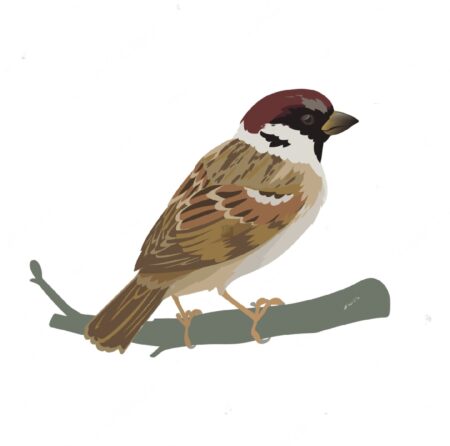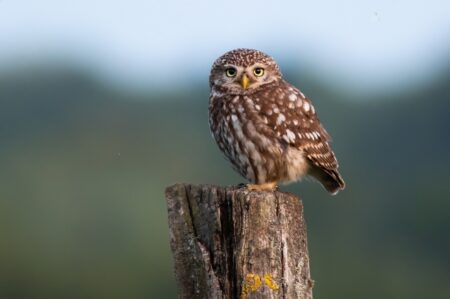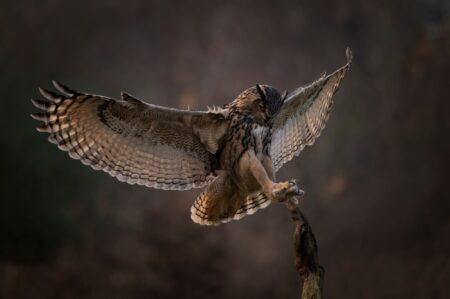Are Birds Predators?
Birds are a diverse group of animals that can be found in almost every part of the world. They come in all shapes and sizes, from the tiny hummingbird to the majestic eagle. While many people may associate birds with singing, flying, and building nests, some birds are also known for their predatory behaviors. In this discussion, we will explore the topic of whether birds can be considered predators.
First, let’s define what a predator is. A predator can be defined as an animal that hunts, kills, and feeds on other animals for survival. A predator is a carnivore, meaning it primarily feeds on meat and is at the top of the food chain. So, can birds be considered predators based on this definition?
The answer is yes. Birds that primarily feed on other animals, such as fish, insects, rodents, and other birds, can be classified as predators. These birds have adaptations that make them efficient hunters, such as keen eyesight, sharp talons, and strong beaks.
One example of a predatory bird is the bald eagle, the national bird of the United States. These large birds of prey have strong talons that they use to catch fish, small mammals, and even other birds. They also have excellent eyesight, allowing them to spot their prey from a great distance.
Another example is the peregrine falcon, known for its incredible speed and agility in flight. These birds can reach speeds of up to 200 miles per hour when diving to catch their prey, which includes other birds such as pigeons and ducks.
However, not all birds can be considered predators. Some birds, such as chickens and ducks, primarily feed on plants and insects and don’t actively hunt and kill their prey. These birds are considered omnivores rather than predators.
It’s also worth noting that not all predatory birds are at the top of the food chain. Some larger predators, such as bears and wolves, can also prey on smaller predatory birds.
All in all, birds can indeed be considered predators based on their hunting and feeding behaviors. While some birds, like chickens and ducks, may not fit into this category, many birds have evolved to be efficient hunters and play a crucial role in maintaining the balance of their ecosystems.
Are Birds Predators?
Some birds are predators, meaning they hunt and feed on other animals for survival. Examples of predatory birds include eagles, hawks, falcons, owls, and many species of raptors. These birds have sharp talons and beaks adapted for catching and killing prey. They often have excellent eyesight, agility, and hunting skills. However, not all birds are predators. Some birds, such as ducks, geese, and swans, are herbivores and mainly feed on plants. Other birds, like seagulls and crows, are omnivores and have a varied diet that includes both plants and animals.
How Do Birds Sense Predators?
- Birds have evolved a variety of senses that help them detect and avoid potential predators. These senses include sight, sound, smell, and touch. Here is a breakdown of how birds use each of these senses to sense predators:
- Sight: Birds have excellent eyesight, as their eyes are specially adapted for hunting and detecting predators. They have a wide field of vision and can see both near and far objects clearly. This helps them spot potential predators from a distance and gives them enough time to escape.
- Sound: Birds have a keen sense of hearing and can hear a wide range of frequencies. They can detect the faintest of sounds which helps them locate predators that may be approaching. Birds are also able to recognize the sound of predator calls, such as the warning calls of other birds, and respond accordingly.
- Smell: While not as developed as in mammals, birds do have a sense of smell that allows them to detect chemical cues in the environment. They can use this sense to detect potential predators by picking up on their scent. This is especially useful for birds that forage on the ground, as they can smell predators that may be lurking nearby.
- Touch: Birds have highly sensitive feathers on their body that can detect the slightest of movement and changes in the air. This helps them sense when predators are nearby, even if they cannot see or hear them. Birds can also use their feet to feel vibrations on the ground, which can alert them to the presence of predators.
Overall, birds use a combination of these senses to sense predators and avoid being caught. They have evolved these senses as a survival mechanism and have become quite skilled at using them to stay safe in their environments.
SEE ALSO: Do Owls Eat Birds?
Do Birds Protect Each Other?
Yes, birds do protect each other in a variety of ways. Some species form flocks, where multiple birds work together to watch for predators and defend the group. Other birds will call out to alert nearby birds of danger. Some birds also engage in mobbing behavior, where multiple birds will harass and attack a predator to protect themselves and other nearby birds. Additionally, some bird species will actively defend their nesting territory to protect their young.
How Do Birds Warn Each Other of Danger?
Birds have several strategies for warning each other of danger:
- Vocalizations: Birds communicate through a variety of vocalizations to warn each other of potential danger. For example, some birds have specific alarm calls that alert their flock members to different types of predators.
- Visual cues: Birds also communicate through visual cues, such as body language and wing movements, to convey information to each other. For instance, a bird may flap its wings to signal a predator in the area.
- Mobbing: Some bird species have a behavior called mobbing, where they all gather and make loud alarm calls and swoop at a potential threat to scare it away. This tactic is often used against predators that are larger or more dangerous than the birds themselves.
- Postures and signals: Birds may also use different postures and signals to warn each other of danger. For example, a bird may puff up its feathers or stand tall on a perch to signal to other birds that danger is near.
- Chemical signals: Birds also use chemical signals to communicate with each other. They may release pheromones, which are scent chemicals, to alert other birds of potential threats.
- Social learning: Birds can also learn from observing the behavior of other birds. If one bird notices a potential danger and takes action, other birds may learn from this and take similar precautions themselves.
Overall, birds have a variety of ways to warn each other of danger, and they rely on these strategies to stay safe and protect their flock.
What Eats Birds?
Many different animals eat birds as part of their diet. These include:
- Predatory birds like eagles, hawks, and falcons
- Carnivorous mammals like foxes, wolves, and coyotes
- Reptiles like snakes, lizards, and crocodiles
- Large fish like pike, bass, and catfish
- Insects like praying mantises, dragonflies, and wasps
- Small mammals like weasels, rats, and shrews
- Other birds, such as owls and larger predatory birds
- Humans (as a source of food)
Some bird-eating animals specialize in hunting and consuming birds, while others will opportunistically feed on them if given the chance.
Bird Predators
Bird predators are any birds that hunt and eat other birds. This can include raptors such as hawks, eagles, falcons, and owls, as well as larger birds like herons and gulls. These birds are equipped with sharp talons and beaks and often have excellent eyesight and flying abilities which allow them to catch their prey in mid-air or on the ground. Some common prey for bird predators include small birds, rodents, fish, insects, and other small animals. These predators play an important role in the ecosystem by controlling the population of their prey species and helping to maintain a balanced food chain.
Methods That Birds Use to Avoid Predators
- Camouflage: Some bird species have evolved to have camouflage patterns and colors that help them blend into their surroundings. This makes it difficult for predators to spot them, giving them a better chance of avoiding an attack.
- Flight: Birds have the ability to fly, which allows them to quickly escape from predators by gaining altitude or flying to a safer location.
- Group living: Many bird species live in flocks or groups, which provides safety in numbers. When a predator approaches, members of the group can work together to distract or intimidate the predator, making it less likely to attack.
- Alarm calls: Birds use alarm calls to warn other birds of potential danger. These calls can alert other members of the flock to take cover and can also act as a warning to potential predators that they have been detected.
- Defensive behavior: Some birds have developed defensive behaviors to protect themselves from predators. For example, some birds will flash their bright-colored feathers or perform intimidating displays to scare off predators.
- Building nests in hidden locations: Birds often hide their nests in well-concealed areas such as dense foliage or high up in trees. This makes it difficult for predators to find and attack their nests.
- Distraction displays: Some bird species use distraction displays to draw a predator’s attention away from their eggs or young. This can include feigning injuries or loudly flapping wings to distract the predator and give the nestlings a chance to escape.
- Nocturnal behavior: Many bird species are active at night when there are fewer predators around. This can help them avoid detection and increase their chances of survival.
- Mimicry: Some birds have the ability to mimic the calls of other species, which they may use to confuse predators or defend their territory.
- Predation avoidance: Birds may actively avoid areas where predators are known to frequent, such as staying away from open fields when there are known predators hunting in the area. They may also avoid areas with high levels of human disturbance, which can attract predators.
SEE ALSO: How To Attract Bird To Feeders: Step-by-Step Guide
FAQs
Q. Do snakes eat birds?
A. Yes, some snakes do eat birds as part of their diet.
Q. Are birds predators or birds?
A. Birds can be both predators and prey. Some species of birds are predators, meaning they hunt and feed on other animals, while other species are prey, meaning they are hunted and eaten by other animals. Some birds are also scavengers, feeding on dead animals.
Q. Is the Owl a bird of prey?
A. Yes, the owl is a bird of prey. They have sharp talons, beaks, and excellent eyesight, and hunt small animals such as mice, insects, and fish for food.
Q. Is a bird of prey a predator?
A. Yes, a bird of prey is a predator, meaning they hunt and eat other animals for food.
Q. Do birds migrate to avoid predators?
A. Yes, some bird species migrate to avoid predators.
Conclusion
In conclusion, while some birds may exhibit predatory behavior, not all birds can be classified as predators. The term “predator” is typically used to describe animals that hunt and kill other animals for food. While some birds do fit this description, many species of birds are omnivorous or herbivorous and do not rely primarily on hunting for sustenance. Additionally, not all birds have the physical characteristics or behaviors that are typically associated with predators, such as sharp claws or a strong beak.

